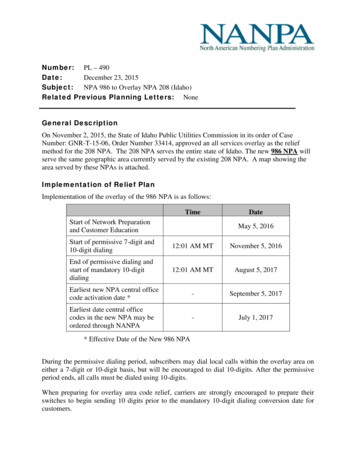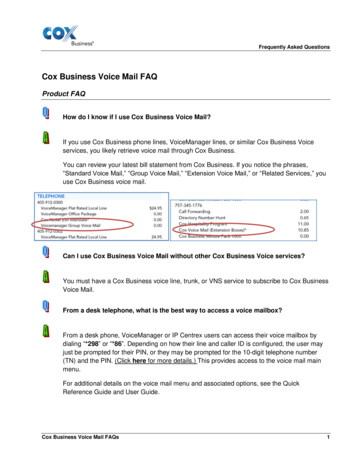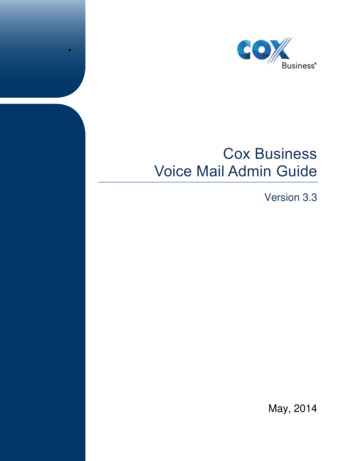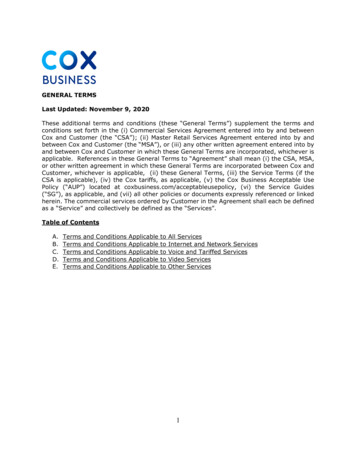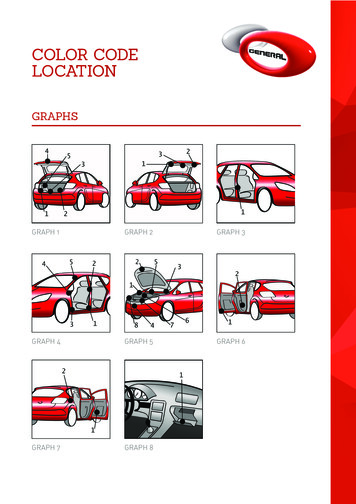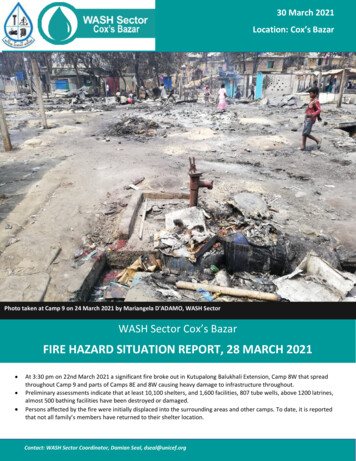
Transcription
30 March 2021Location: Cox’s BazarPhoto taken at Camp 9 on 24 March 2021 by Mariangela D'ADAMO, WASH SectorWASH Sector Cox’s BazarFIRE HAZARD SITUATION REPORT, 28 MARCH 2021 At 3:30 pm on 22nd March 2021 a significant fire broke out in Kutupalong Balukhali Extension, Camp 8W that spreadthroughout Camp 9 and parts of Camps 8E and 8W causing heavy damage to infrastructure throughout.Preliminary assessments indicate that at least 10,100 shelters, and 1,600 facilities, 807 tube wells, above 1200 latrines,almost 500 bathing facilities have been destroyed or damaged.Persons affected by the fire were initially displaced into the surrounding areas and other camps. To date, it is reportedthat not all family’s members have returned to their shelter location.Contact: WASH Sector Coordinator, Damian Seal, dseal@unicef.org
30 March 2021Location: Cox’s Bazar The damage has resulted in a significant response and to date, for the WASH response, WASH Partners from Government,4 UN, 6 INGO, 4 National NGO and 1 organization have reported being part of the response.Initial funding needs are estimated to be at least 5.5 million USD to replace the lost infrastructure with the approvedsector design.Current cost estimates do not incorporate the emergency element of the response and the used contingency stock.DAMAGES OF WASH INFRASTRUCTURE Damage reported was either partial or full as follows;o Water System – Networks sustained damage to exposed plastic taps and pipework, and distribution tank rubberliners, along with power supply systems. Deep tubewells and handpumps were structurally serviceable in mostinstances but required the replacement of mechanical or PVC internal parts. It should be noted that some waternetworks cross camp boundaries.o Sanitation – Latrines were severely damaged with the collapse of structures due to frame material of wood orconcrete columns that could not withstand the heat. The sanitary pan in the base was in most structures meltedto various degrees. Bathing spaces were structurally affected in a similar way to latrines. Similarly, hand washingstations, heavily scaled up as COVID-19 response, got partially or completely damaged.o Solid Waste Management – Household collection bins were destroyed, and numerous collection facilities weredamaged, including the collection and recycling locations. Solid Waste Management – In camp 8E and 8W, theaffected areas have not resulted in the complete loss of the operating system and remedial works and supply arein process. Within camp 9, only minimal concrete structures have survived.o Hygiene promotion and NFI items – Due to the urgency of the situation, household were unable to take in locationsof displacement water storage containers or other hygiene items such as soap and menstrual hygiene materials.WASH committee are expected to have been disrupted due to population’s sprawl, although partners are reestablishing community-based mechanisms at the moment. Faecal Sludge Management – Treatment systems andpumped networks were affected by the fire with the complete loss of the treatment system in camp 9.o The need for clearance of waste is recognized as a major challenge to the re-establishment of the camp butresidents in and around the camp have already engaged in value material reclamation.o There is a large quantity of waste that is being generated by the distribution of prepacked goods using no valueor non-recyclable material, along with distribution of water bottles with food. The quantity of waste will impacton the ability to keep the camps clean from waste and add an additional load to the already stressed landfill.o The land fill has just been granted permission to expand and will increase from 8,000 m3 to 22,000 m3, and worksare due to start immediately. The landfill has received the equivalent of 6 months waste in the space of 7 daysand now has limited capacity, estimated at 800 m3, equivalent to about 5-7 days at current loading rates from firedamaged materials and other solid waste, including drainage clearance material.Contact: WASH Sector Coordinator, Damian Seal, dseal@unicef.org
30 March 2021Location: Cox’s BazarASSESSMENT FOR DAMAGES WASH FACILITIES FOR FIRE INCIDENCETYPE OF FACILITY# OF FACILITYLatrine811Bathing Shed335Tube-well449FSM6CONDITION TYPE# OF FACILITYPartially DamagedFully DamagedPartially DamagedFully DamagedPartially DamagedFully DamagedSSU PartiallyDamagedDEWATS partiallydamaged746653082741336REMARKSUpgradation NeededUpgradation NeededUpgradation Needed33Upgradation Needed3354498116Bathing ShedsAffectedTube Wells AffectedLatrinesAffectedFSM Plants AffectedPOTENTIAL FIRE IMPACT ON TUBE WELLSContact: WASH Sector Coordinator, Damian Seal, dseal@unicef.orgPOTENTIAL FIRE IMPACT ON LATRINES
30 March 2021Location: Cox’s BazarPOTENTIAL FIRE IMPACT ON WATER NETWORKSPOTENTIAL FIRE IMPACT ON FSM SITESContact: WASH Sector Coordinator, Damian Seal, dseal@unicef.orgPOTENTIAL FIRE IMPACT ON BATHING SHEDSPOTENTIAL FIRE SWM SITES
30 March 2021Location: Cox’s BazarWASH SECTOR PARTNERS FIRE HAZARD RESPONSE WASH sector partners responded early in the evening with water provision that assisted in the response to extinguish thefire by providing water to firefighting equipment and localized extinguishing of fire. At the same time, water was madeavailable for distribution at the football field in camp 8E where many persons had gathered but was delayed in arrivingdue to blocked access by firefighting equipment. Initially water was delivered manually using jerry cans. The following day WASH Rapid response teams were deployed to assess the impact and quickly identified the needs.oIn recognition of the needs for water, temporary distributions took place using mobile tap stands and issuing jerrycans. Repairs to water networks, deep tube wells and handpumps was started within 24 hours and has continuedsince. Where possible production boreholes, powered by temporary generators, have been linked to temporarytanks and bladders to facilitate operation of networks. Where this is not possible, bladders have been locatedbased upon accessibility to give sphere standard coverage of the camp. Aqua tabs have been issued to familiesand bucket chlorination is being instigated in 64 locations but not across the whole response where feacalcontamination is being monitored. Water trucking has ceased in camps 8E and 8W and is set to be phased out incamp 9 within 10 days.oSanitation facility repairs started with 24 hours with the provision of temporary structural uprights, roof and coverfrom view sheeting as a means of allowing access to the facilities although it is recognized that this is onlytemporary. Where there was need to replace the sanitary pan, design differences have resulted in some of thelatrines requiring a complete base slab replacement and so hindered rapid repairs.oIn support of hygiene, promotion sessions have been conducted that concentrate on aquatabs and use of safedrinking water, hand washing, nonuse of dysfunctional latrines. Mobile handwashing stations have been deployedto support implementation of hygiene barriers.oNFI various emergency response kits have been distributed at the affected camps with sufficient coverage for allfamilies for water containers, soap and aqua tabs. Menstrual Hygiene materials are being distributed and theaffected camp level area and other sectors are responding at displaced locations.oSolid Waste Management –Remedial works and supply are in process for Camps 8E and 8W to bring the systemback into full operation. Within camp 9, the loss of the complete operational system is a major issue and supplyof HH bins is under way but other resolutions to waste handling are being sort to reduce waste entering thelandfill.oFeacal Sludge Management – Desludging of latrines continues and has increased in volume removed to reducethe level of all pits. With the loss of the treatment systems, alternative locations have been negotiated that for ashort period can sustain additional loading. Repairs will continue to systems but due to design limitations, not allsystems can be immediately repaired, which may take several weeks even for temporary solutions.Contact: WASH Sector Coordinator, Damian Seal, dseal@unicef.org
30 March 2021Location: Cox’s BazarPARTNERS RESPONSE FROM 22 MARCH TO 28 MARCHIntervention/Activities# of Aquatabs DistributedWater trucking/metre cubeLitres of water/ lte# of Portable/Emergency Latrine Installation# of Latrine Repaired# of Portable/Emergency Bathing cubicles Installed#Bathing facilities Repaired# of Tubes Wells Installed# of Tube Well Repaired# of Tap stands Installed# of Tap Stands Repair# Handwashing Device Installed#Handwashing Devices Repaired# of Water Network repair# families reached with soaps# of families reached with MHM Kits# of families reached with Jerry Cans**# of families reached with Buckets8E8WTotalTotalTotalTotal 800459Landfill ActivityVolume of Metal Waste Collected (m3)# of Truck Trips for Metal Waste CleanupVolume of debris Collected (m3)# of Truck Trips for Debris CleanupSW Collected (kg)8,530** The distribution of Jerry Cans were conducted immediately after the hazard in the affected camps in a blanketcoverage approach, to all individuals seeking support. Hence the numbers are not limited to the single distribitionsamong the affected householdsContact: WASH Sector Coordinator, Damian Seal, dseal@unicef.org
30 March 2021Location: Cox’s BazarIntervention/Activities# of Portable/Emergency Bathing facilitiesInstalled#Bathing facilities Repaired# Undamaged Bathing Facilities LatrineCurrent Total Operational BathingFacilities# of Latrine Repaired# of Portable/Emergency Latrine facilitiesInstalled# Undamaged LatrineCurrent Total Operational LatrineFacilities# of Tube Well Installed# of Tube Well Repaired# Undamaged TubewellsCurrent Total Operational Tube wells# of Water Network repair# Undamaged Water NetworksCurrent Total Operational 736510612742956220010865821668120Remarks as per Sphere Standards forEmergency Phase 1The standard for bathing facility is 1 facilityper 50 people. In 9 the partners have beenable to ensure 1 facility/55 people within 6days of the eventThe standard for latrine is 1 toilet per 50people. In 8W partners have been able toprove 1 latrine/33 people and in Camp 9, 1latrine/ 23 people which exceeds thestandard already15 litre per person per day, 250 people pertap15 litre per person per day, 250 people pertapPhoto taken at Camp 8E on 29 March 2021 by Mariangela D'ADAMO, WASH SectorContact: WASH Sector Coordinator, Damian Seal, dseal@unicef.org
30 March 2021Location: Cox’s BazarCHALLENGES AND WAY FORWARDThe main challenges for the WASH sector response are the loss of the Faecal Sludge Management Systems and the challengesto Solid waste management from food distribution cartons. Ensuring dignity and protection with temporary structures willremain a challenge for users, especially females and exasperate the issue of accessing facilities at night. WASH facility designssubmitted for review must be hastened through the permission process to assist in the build back better approach.As the response moves forward, the re-establishment of facilities must incorporate the latest gender inclusive design that helpaddress many of the long-term issues faced by users in terms of gender, age and disability. To enable this, WASH facilities mustbe allocated the space, in the appropriate location to better serve the needs of the users and improve usage through improvedprotection for the vulnerable, including allocations based on shelters not sphere guidance figures. Funding of approximately 5.5 Million USD will be required to complete the necessary infrastructure works but does not include replenishing theemergency stocks or imminent future NFI distributions.Photo taken at Camp 9 on 29 March 2021 by Mariangela D'ADAMO, WASH SectorContact: WASH Sector Coordinator, Damian Seal, dseal@unicef.org
The sanitary pan in the base was in most structures melted . TYPE OF FACILITY # OF FACILITY CONDITION TYPE # OF FACILITY REMARKS . Photo taken at Camp 8E on
